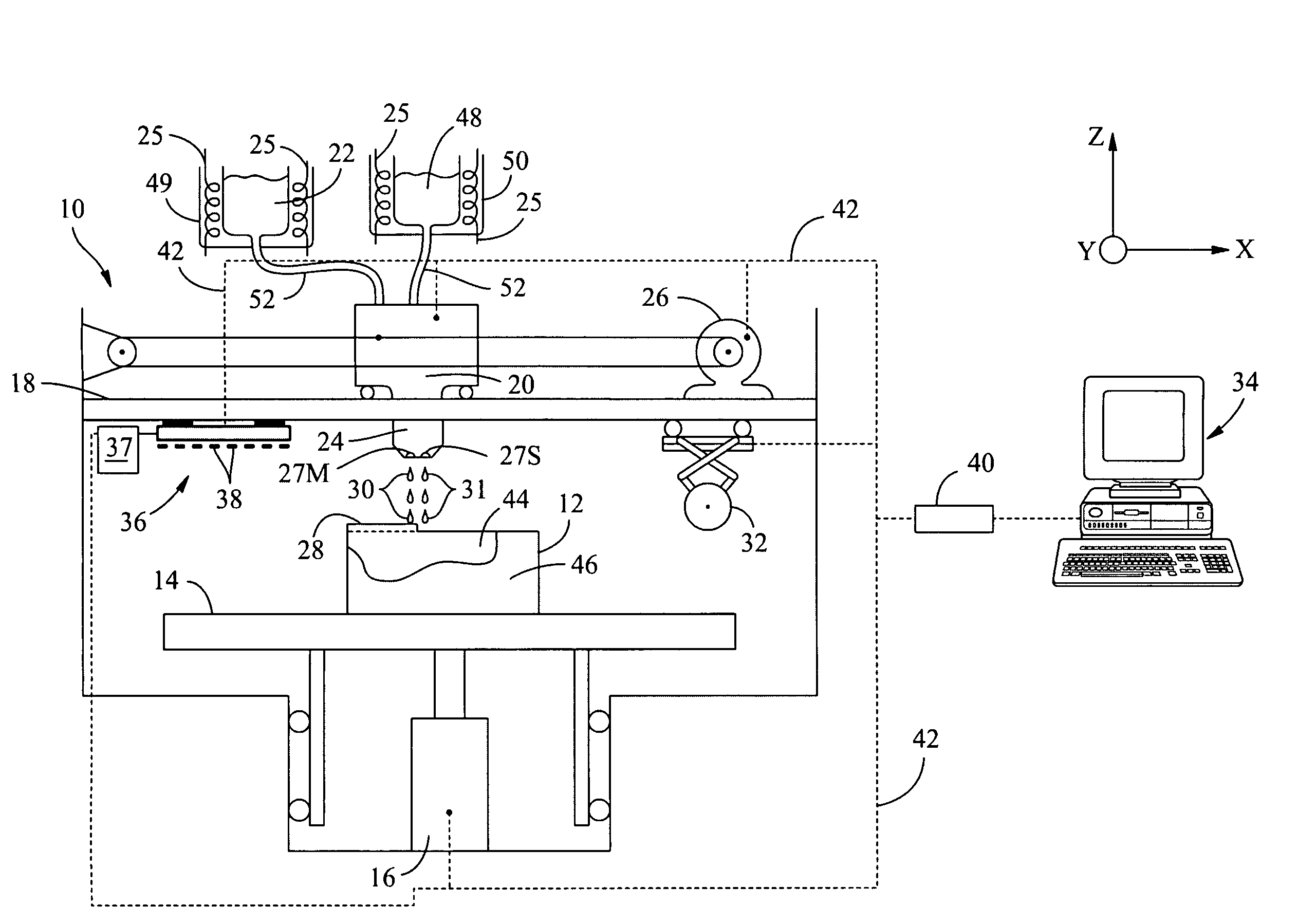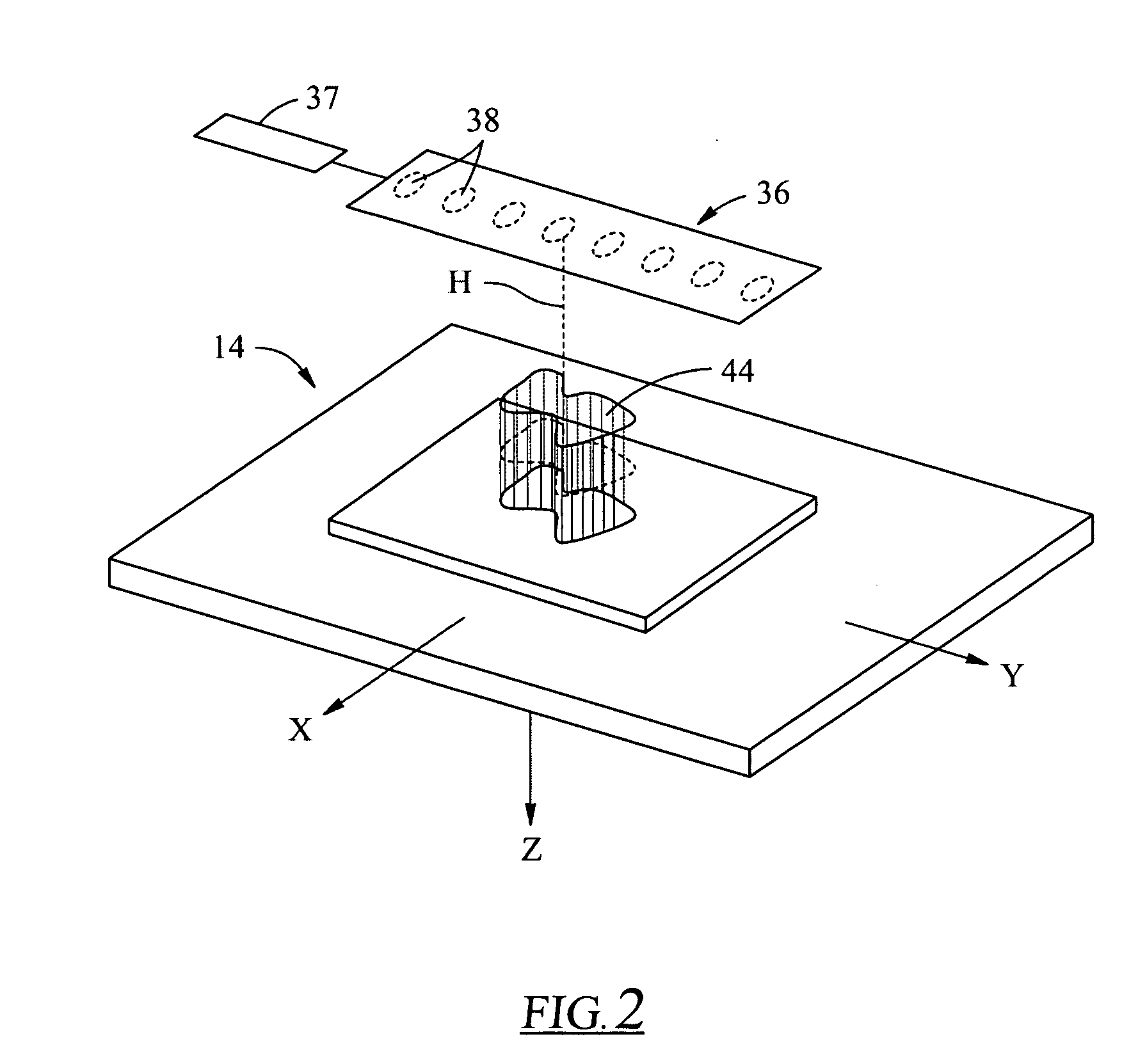Selective Deposition Modeling Using CW UV LED Curing
a technology of selective deposition modeling and led curing, which is applied in the field of solid freeform fabrication, can solve the problems of affecting the quality of cw uv led curing, and unable to effectively initiate curing in these materials
- Summary
- Abstract
- Description
- Claims
- Application Information
AI Technical Summary
Benefits of technology
Problems solved by technology
Method used
Image
Examples
example curable
Phase Change Materials
[0044]A number of radiation-curable phase change formulations have been developed for being dispensed by a dispensing device, such as a Z850 print head available from Xerox Corporation of Wilsonville, Oreg. The components of four exemplary build material formulations are provided by weight percent in Table 1, below.
TABLE 1Mfg. IDGeneral ComponentNo.NameEx. 1Ex. 2Ex. 3Ex. 4CN980Urethane Acrylate7.2% 6.5%CN981Urethane Acrylate26%E3200Epoxy Acrylate14%6.0%CN975Hexafunctional7.2% Urethane AcrylateCN2901Urethane Acrylate27.5% 27%18.7% SR203TetrahydrofurfurylMethacrylateSR205Triethylene glycol33%46.5% 41.05% dimethacrylateSR3402-phenoxyethylmethacrylateSR313Lauryl methacrylate18%SR454Ethoxylated34.5% TrimethylolpropaneTriacrylateSR604polypropylene12.0% glycolmonomethacrylateCD406Cyclohexane30%dimethanoldiacrylateSR493DTridecyl19%MethacrylateADS038Urethane wax 7%5.3% 10%10.0% ADS043Urethane wax4.3% 6%1.5% 2.0%I-184Photo-initiator 2% 2% 2%3.75% TOTAL100% 100% 100% 1...
example sdm
Apparatus
[0105]Now referring to FIG. 13, the SDM apparatus schematically shown in FIG. 3 is shown as 12. To access the build environment, a slideable door 82 is provided at the front of the apparatus. The door 82 does not allow radiation within the apparatus to escape into the environment. The apparatus is configured such that it will not operate or turn on with the door 82 open. In addition, when the apparatus is in operation, the door 82 will not open. Material feed doors 84 are provided so that the curable phase change material can be inserted into the apparatus through one door 84 and the non-curable phase change material can be inserted into the apparatus through the other into their respective feed magazines (not shown). A waste drawer 86 is provided at the bottom end of the apparatus 10 so that the expelled waste material can be removed from the apparatus. A user interface 88 is provided which is in communication with the external computer previously discussed which tracks re...
PUM
| Property | Measurement | Unit |
|---|---|---|
| irradiance | aaaaa | aaaaa |
| central wavelength | aaaaa | aaaaa |
| central wavelength | aaaaa | aaaaa |
Abstract
Description
Claims
Application Information
 Login to View More
Login to View More - R&D
- Intellectual Property
- Life Sciences
- Materials
- Tech Scout
- Unparalleled Data Quality
- Higher Quality Content
- 60% Fewer Hallucinations
Browse by: Latest US Patents, China's latest patents, Technical Efficacy Thesaurus, Application Domain, Technology Topic, Popular Technical Reports.
© 2025 PatSnap. All rights reserved.Legal|Privacy policy|Modern Slavery Act Transparency Statement|Sitemap|About US| Contact US: help@patsnap.com



